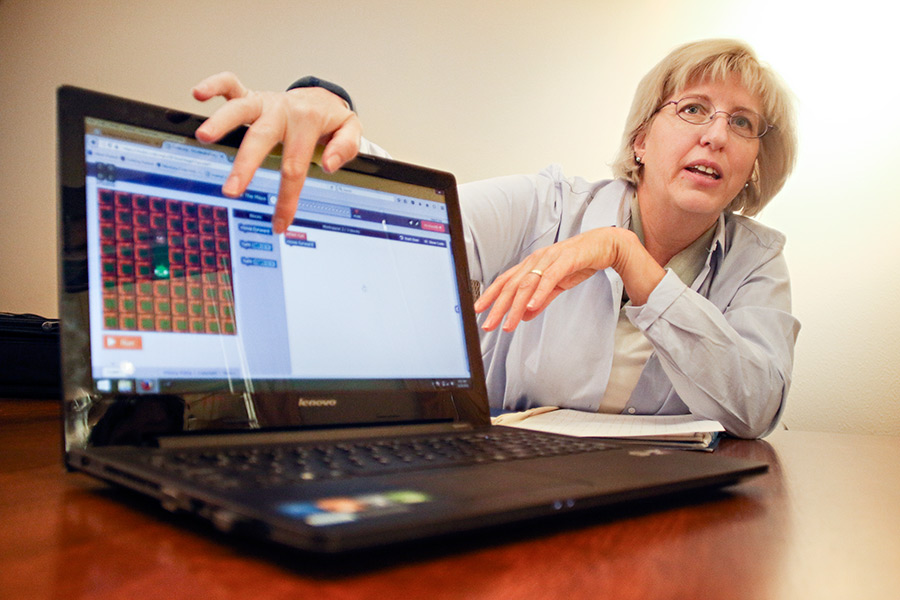When Marianne Smith was learning the language of computer coding in college, it required a bag to hold all the punch cards needed to tell the computer what to do.
It was a sign of the times – from the time people started coding computers up until the mid-1980s, most programmers used punch cards to keep track of their programs, line by line. To edit a program, the cards were reorganized, edited, removed, replaced, and backed up by a second deck or written to magnetic tape.
“That wasn’t too fun,” Smith said, recalling how an ill-timed slip or fall could result in all the cards scattering willy-nilly to the floor.
Learning to code was part of her education to become an industrial engineer, a profession that had almost no women in it when Smith was working for NASA or Lockheed Martin.
“When I was first hired, they asked if I was going to get pregnant, I had to dress like a man, look like a man, even though I was being paid less,” Smith said.
She was told the men had wives and families to provide for, so it made sense that they should earn more than she did for the same work.
“Things aren’t that way anymore,” Smith said. “You can be yourself.”
In that spirit, Smith has volunteered to start up Kalispell’s branch of Montana Code Girls, an offshoot of Big Sky Code Academy that seeks to connect girls and young women with technology. Starting Oct. 6, there will be free coding classes for girls ages 9 to 19, every Thursday at Sykes Diner. The class will tie together coding and entrepreneurship opportunities.
Montana Code Girls’ mission is to empower girls’ interest in science, technology, engineering, and math, abbreviated as STEM. Many of the local schools have begun integrating coding and computer languages into their curriculum, but are still having some trouble attracting girls to the classes.
Devin Holmes, who founded Montana Code Girls with his wife Christine, said the idea started after the couple saw the documentary “CodeGirl,” tracking teams competing in app creation. They screened it in Missoula and Bozeman, and had parents approach them about the classes.
“So we said, ‘Yeah, sure, we’ll create the program,'” Holmes said. “We want to get young girls in the age range of 9 to 19 interested in technology, in this case software, and start to demystify technology and create an environment where they can learn without social peer pressure.”
An eight-week pilot of the program showed promise, and Montana Code Girls starts in Kalispell, Helena, Great Falls, and Bozeman this fall.
STEM education has to start early in order to battle the social ideas that girls shouldn’t be in these professions, Smith said.
“I do think that once girls hit middle school, especially the end of middle school, the party’s over,” she said.
So far, most of the interest in the class has been from 9 to 12 year olds. Smith said by the time most students hit high school, they’ve got an idea of what they’d like to study, but coding experience early on could affect that as well.
Montana Code Girls is a free afterschool program, and no experience is necessary. Kalispell students will need to bring a laptop while Montana Code Girls waits on a grant for 150 computers.
During the fall semester, classes will get the girls familiar with binary, Smith said, and they’ll play games to get them familiar with code blocks containing prewritten code. Then, eventually they’ll start looking at what’s behind the blocks.
In the spring, the students will focus on a the Technovation Challenge, a global competition for girls 9 to 19 to build a mobile app that solves a social problem in their community. They have to create a business plan, a pitch video, a logo, conduct a market survey, an explanation video of how the app works, and more.
If Montana has enough teams, it can become an official regional competition, and the winners would go on to the semifinals at the global level. If they make it to the finals in San Francisco, they compete for a $10,000 grand prize.
“It’s really an entrepreneurial challenge,” Holmes said.
Coding is expected to be one of the most important job skills a person can have on their resume, according to Burning Glass, which tracks job market analytics. In 2015, there were 7 million job openings that valued coding skills, which equates about 20 percent of the jobs that pay at least $15 an hour.
The beauty of coding is it is a mere medium waiting to be explored by the user. Girls can use it to bolster whatever their existing interests are, Smith said. For example, graphic design students can learn coding and create their own work. The people who code on the design of major apps are considered artists, she said.
“There’s all these things that you can do,” Smith said. “You could create a market for what you’re doing.”
By summer 2017, Montana Code Girls will fall under the umbrella of Montana Code Kids to involve a program for boys, Holmes said, and the program will eventually include a multi-week overnight coding camp.
But Smith is focused on the immediate goal of finding students in the Flathead. She said the class will be challenging, but it will also be a place to meet people and have a good time while learning.
“I think it’s going to be really cool for the girls who participate,” Smith said.
For more information on Montana Code Girls, including registration, visit www.bigskycodeacademy.org/montanacodegirls, or email Marianne Smith at [email protected].
